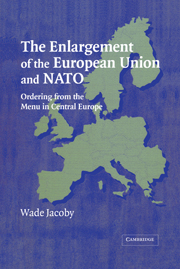Book contents
- Frontmatter
- Contents
- List of Tables, Graph, and Figures
- Preface and Acknowledgments
- Introduction: Ordering from the Menu in Central Europe
- 1 Emulation as Embedded Rationalism
- 2 Emulation as Rapid Modernization: Health Care and Consumer Protection
- 3 Emulation Under Pressure: Regional Policy and Agriculture
- 4 The Struggle for Civilian Control of the Military
- 5 Military Professionalization in War and Peace
- 6 Using Theory to Illuminate the Cases
- 7 Synthesis and Sequence: Juxtaposing Theory Traditions
- 8 Extensions and Conclusions
- Appendix: Selected List of Persons Interviewed
- Works Cited
- Index
4 - The Struggle for Civilian Control of the Military
Published online by Cambridge University Press: 06 July 2010
- Frontmatter
- Contents
- List of Tables, Graph, and Figures
- Preface and Acknowledgments
- Introduction: Ordering from the Menu in Central Europe
- 1 Emulation as Embedded Rationalism
- 2 Emulation as Rapid Modernization: Health Care and Consumer Protection
- 3 Emulation Under Pressure: Regional Policy and Agriculture
- 4 The Struggle for Civilian Control of the Military
- 5 Military Professionalization in War and Peace
- 6 Using Theory to Illuminate the Cases
- 7 Synthesis and Sequence: Juxtaposing Theory Traditions
- 8 Extensions and Conclusions
- Appendix: Selected List of Persons Interviewed
- Works Cited
- Index
Summary
American advisors have conducted top-to-bottom assessments of the armed forces of Lithuania, Latvia, Estonia, Bulgaria, and Romania and have written blueprints for their remodeling. In the Czech Republic, Poland, Hungary, Romania, and Slovenia, they are revamping command-and-control systems … American advisors have drafted military codes of justice and tactical war-fighting doctrines … Poland is allowing an eight-man U.S. military team to help reshuffle its insular general staff, which has resisted transferring control over troops to civilian authorities. The Americans say they will help Poland create a NATO-style joint staff tied to an interagency political process like that in the United States.
(Washington Post, Dec. 14, 1998: A1)This chapter and the next take up the issue of emulation, both voluntary and under pressure, in the military realm. If this front-page story quoted from the Washington Post in 1998 seemed a little breathless about the ability of the United States to remake CEE societies, chapters 2 and 3 have hopefully suggested that the process is not quite so straightforward. The epigraph is typical of one unrealistic way of thinking about external influence — namely, that it is essentially a teaching/consulting process. But there is another even more misleading approach, which is to assume that external models play no role at all and that domestic factors fully explain institutional change in CEE.
- Type
- Chapter
- Information
- The Enlargement of the European Union and NATOOrdering from the Menu in Central Europe, pp. 116 - 153Publisher: Cambridge University PressPrint publication year: 2004



